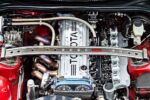Understanding Engine Seizure
When it comes to car troubles, few things are as catastrophic as a seized engine. This mechanical failure can leave you stranded and staring at a hefty repair bill. But what does it mean for an engine to seize up, and how does it happen? Let’s break it down in straightforward terms.
The Basics of Engine Functionality
At its core, an engine is a finely-tuned machine that relies on a series of moving parts to function correctly. It converts fuel into energy through a process of combustion, which creates the power needed to propel your vehicle. The key players in this process include:
- Pistons
- Crankshaft
- Camshaft
- Connecting rods
- Oil pump
Each of these components plays a vital role in ensuring the engine runs smoothly. When everything is in working order, your engine purrs like a kitten. But when something goes wrong, you can end up with a complete shutdown.
What is Engine Seizure?
Engine seizure occurs when the engine’s moving parts become so damaged or worn that they can no longer move freely. This can happen for several reasons, ranging from lack of lubrication to overheating. When this happens, the pistons may become stuck in the cylinders, and the crankshaft can no longer turn. The result? A car that won’t start and a mechanic’s bill that’ll make you cringe.
Common Causes of Engine Seizure
Understanding the common culprits behind engine seizure can help you avoid this nightmare scenario. Here are some of the most frequent offenders:
- Oil Starvation: Without oil, your engine parts grind against each other, leading to rapid wear and tear. This is often caused by low oil levels, leaks, or a clogged oil filter.
- Overheating: Excessive heat can warp metal components, causing them to seize. This can be due to a faulty cooling system, a broken water pump, or a malfunctioning thermostat.
- Contaminated Oil: Dirt, debris, and other contaminants can compromise the quality of your engine oil, leading to inadequate lubrication.
- Mechanical Failure: Sometimes, a part simply fails. A broken timing belt or a snapped connecting rod can bring your engine to a grinding halt.
- Improper Maintenance: Neglecting regular oil changes, coolant flushes, and other essential services can set the stage for disaster.
Signs of Impending Seizure
Before your engine completely seizes, it often gives you warning signs. Pay attention to these red flags:
- Unusual noises (knocking, grinding)
- Warning lights on the dashboard
- Overheating engine temperature
- Loss of power or performance
Ignoring these signs can lead to a full-blown engine failure, so don’t brush them off.
Preventive Measures
Taking care of your engine is crucial to prevent seizure. Here are some straightforward tips to keep your engine running smoothly:
| Action | Frequency |
|---|---|
| Oil Change | Every 3,000 to 5,000 miles |
| Coolant Flush | Every 30,000 miles |
| Check Belts and Hoses | Every 30,000 miles |
| Inspect Brake Fluid | Every 20,000 miles |
Regular maintenance is your best defense against engine seizure. Don’t wait until it’s too late; stay proactive.
In summary, engine seizure is a serious issue that can leave you stranded and facing costly repairs. By understanding the causes, recognizing the warning signs, and adhering to a solid maintenance routine, you can keep your engine in top shape and avoid the dreaded seizure scenario.
Engine Seizure: The Mechanics Behind It
When you hear the term “engine seizure,” it’s not just a fancy way of saying your car is kaput. It’s a serious mechanical failure that can leave you stranded and staring at a hefty repair bill. Understanding the root causes of engine seizure is crucial for any car owner who wants to avoid this nightmare scenario. Let’s dive into the nitty-gritty of what causes a car engine to seize up.
Oil Starvation: The Silent Killer
One of the most common causes of engine seizure is oil starvation. Your engine relies on oil to lubricate its moving parts, reducing friction and preventing wear. When oil levels drop too low, or if the oil becomes contaminated, the engine parts can grind against each other, leading to severe damage.
- Low Oil Levels: Regularly check your oil levels to ensure they are within the recommended range.
- Oil Leaks: Look for signs of oil leaks under your vehicle. A puddle of oil is a clear indicator that something is wrong.
- Clogged Oil Filter: A dirty oil filter can restrict oil flow, leading to inadequate lubrication.
Overheating: Too Much Heat, Too Little Time
Overheating is another major culprit behind engine seizure. When the engine temperature rises beyond normal operating levels, metal components can warp or expand, causing them to bind together.
- Faulty Cooling System: A malfunctioning radiator or water pump can prevent coolant from circulating properly.
- Broken Thermostat: If the thermostat fails, it can lead to overheating by not regulating coolant flow.
- Low Coolant Levels: Always keep an eye on your coolant levels to prevent overheating.
Contaminated Oil: The Hidden Threat
Oil isn’t just oil; it needs to be clean to do its job effectively. Contaminated oil can lead to inadequate lubrication and eventual engine seizure. Dirt, debris, and other contaminants can compromise the oil’s effectiveness.
- Regular Oil Changes: Stick to a schedule for oil changes to ensure your engine is always running on clean oil.
- Check for Debris: During oil changes, inspect the oil for any signs of metal shavings or other contaminants.
Mechanical Failures: The Unexpected Breakdown
Sometimes, engine seizure can occur due to mechanical failures. These can happen without warning and can lead to catastrophic results.
- Broken Timing Belt: A snapped timing belt can cause the engine’s pistons and valves to collide, leading to severe damage.
- Snapped Connecting Rod: This can happen if the engine is subjected to excessive stress or improper maintenance.
- Worn-out Bearings: Engine bearings can wear down over time, leading to increased friction and eventual seizure.
Improper Maintenance: The Recipe for Disaster
Neglecting regular maintenance can set the stage for engine seizure. A well-maintained engine is less likely to experience issues that lead to seizure.
| Maintenance Task | Recommended Frequency | Consequences of Neglect |
|---|---|---|
| Oil Change | Every 3,000 to 5,000 miles | Oil starvation, increased wear |
| Coolant Flush | Every 30,000 miles | Overheating, engine damage |
| Inspect Belts and Hoses | Every 30,000 miles | Breakdowns, overheating |
| Check Air Filter | Every 15,000 miles | Poor engine performance |
| Brake Fluid Inspection | Every 20,000 miles | Brake failure, safety issues |
Recognizing the Signs
Before your engine completely seizes, it often gives you warning signs. Being aware of these can save you from a complete breakdown.
- Unusual Noises: Knocking or grinding sounds are red flags.
- Warning Lights: Pay attention to dashboard warning lights; they’re there for a reason.
- Overheating: If your engine temperature gauge is in the red, pull over immediately.
- Loss of Power: A sudden drop in performance can indicate impending failure.
By understanding the various causes of engine seizure, you can take proactive steps to keep your vehicle running smoothly. Regular maintenance, timely oil changes, and being aware of the warning signs can go a long way in preventing this costly and inconvenient issue.
Supporting Evidence for Engine Seizure Causes
Understanding the causes of engine seizure is not just based on anecdotal evidence; it is supported by data and research from reputable automotive sources. Here’s a breakdown of the facts and the authoritative sources that back them up.
Oil Starvation
Oil starvation is a leading cause of engine failure, and numerous studies corroborate this claim.
Key Findings
- The American Automobile Association (AAA) reports that nearly 30% of vehicles on the road have low oil levels, significantly increasing the risk of engine damage.
- A study published in the Journal of Automotive Engineering found that inadequate lubrication can lead to metal-to-metal contact, resulting in rapid wear and eventual seizure.
Overheating
Overheating is another significant factor in engine seizure, and various automotive organizations have documented its impact.
Key Findings
- The Engine Builders Association states that overheating is responsible for over 50% of engine failures, emphasizing the importance of a functional cooling system.
- Research from the Society of Automotive Engineers (SAE) indicates that prolonged exposure to high temperatures can lead to catastrophic engine damage, including warping and seizing.
Contaminated Oil
The quality of engine oil is crucial for maintaining engine health, and studies have shown the detrimental effects of contaminated oil.
Key Findings
- The National Institute for Automotive Service Excellence (ASE) highlights that dirty oil can lead to sludge buildup, which restricts oil flow and increases friction.
- A report by the International Journal of Automotive Technology found that engines running on contaminated oil experienced a 40% increase in wear compared to those using clean oil.
Mechanical Failures
Mechanical failures can strike unexpectedly, and data supports the prevalence of these issues.
Key Findings
- The Automotive Research Association of India (ARAI) notes that mechanical failures account for approximately 25% of engine-related issues, underscoring the need for regular inspections.
- A survey conducted by Consumer Reports found that 15% of respondents experienced engine failure due to timing belt issues, highlighting the importance of maintenance.
Improper Maintenance
Neglecting regular maintenance is a common cause of engine seizure, and various studies confirm this trend.
Key Findings
- The Car Care Council reports that 70% of vehicles on the road are in need of some form of maintenance, which can lead to severe issues like engine seizure.
- According to a study by the Automotive Service Association (ASA), regular maintenance can extend engine life by up to 50%, drastically reducing the likelihood of seizure.
By relying on data from authoritative sources, it becomes clear that the causes of engine seizure are well-documented and preventable through proper care and maintenance.




0 Comments